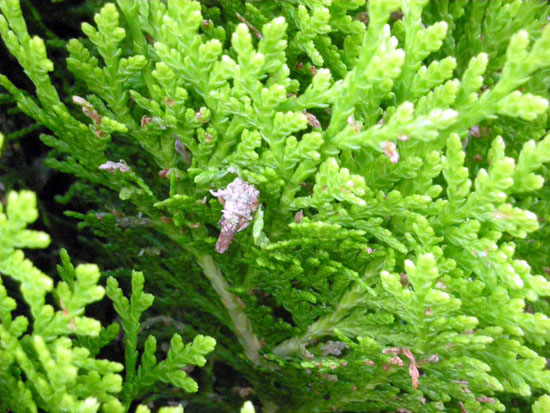Issue 10, June 26, 2009
Bagworms
The emergence of bagworms appears to be a mixed bag this year. There are very high populations that have hatched and settled down to feed in southern Illinois. I saw the highest density of bagworms that I have ever seen in Collinsville on June 22 feeding on arborvitae. Their cases were about one-quarter to one-half inch long, but had not yet caused any obvious damage.
I received information from a landscaper about bagworms feeding in Paxton in east central Illinois on June 18. At that time, they were only about one-eighth inch long and were probably still ballooning to other trees. By now, they will have settled down to feed, making it an appropriate time to treat. As I reported earlier in this newsletter, I checked several female bagworm cases and associated arborvitae in Champaign a couple of weeks ago and found no viable eggs or hatched larvae.
Martha Smith, Extension Horticulture Center Educator, found one-quarter to one-half inch long bagworms in northwestern Illinois. A landscape professional reported viable eggs in bagworm cases north of Chicago within the past week.

What does this all mean? Obviously the cold weather that we had last winter was not severe enough to eliminate most of the bagworms in central and northern Illinois. Traditionally, bagworms were not found north of Interstate 80, but have been found in that area for the last few years. The traditional lack of bagworms north of I-80 may be due to a number of factors. Although minimum temperatures have an effect on insect survival, there are other factors that enter into the situation. Dr. Fredric Miller (Joliet Junior College and Morton Arboretum) and others have investigated super-cooling of insects, and its effect on winter insect survival. When the cold temperatures occur during the winter, temperatures before the cold weather, moisture levels, and various other factors enter into winter survivability.
This points out the need for scouting before insecticide applications are applied. You may encounter areas where the bagworm eggs did not overwinter, but nearby areas could have treatable numbers of young caterpillars. There is no indication that the winter had any effect on bagworm survival in southern Illinois, and populations may be locally very heavy.
Our recommendations for control are to spray with an appropriate insecticide about two weeks after egg hatch, when ballooning to other trees by the larvae has ceased. Hatching should be occurring now in northern Illinois. When ballooning is occurring, you can see larvae hanging by one to three foot long silk strands from the upper branches of previously infested trees. They will have small, brown cases. When they have finished ballooning and are actively feeding, the larvae will be on foliage lower on the tree. Their cases will have bits of green foliage at the open ends. The larvae will not be hanging from silk threads unless they are jarred loose from the plant.
Bacillus thuringiensis kurstaki (Dipel, Thuricide), spinosad (Conserve), and various pyrethroids will be effective as sprays. In areas where spray drift is a problem, the soil-injected Lepitect containing acephate should be effective. It may take a couple of weeks for the Lepitect to start killing caterpillars.--Phil Nixon
Author:
Phil Nixon